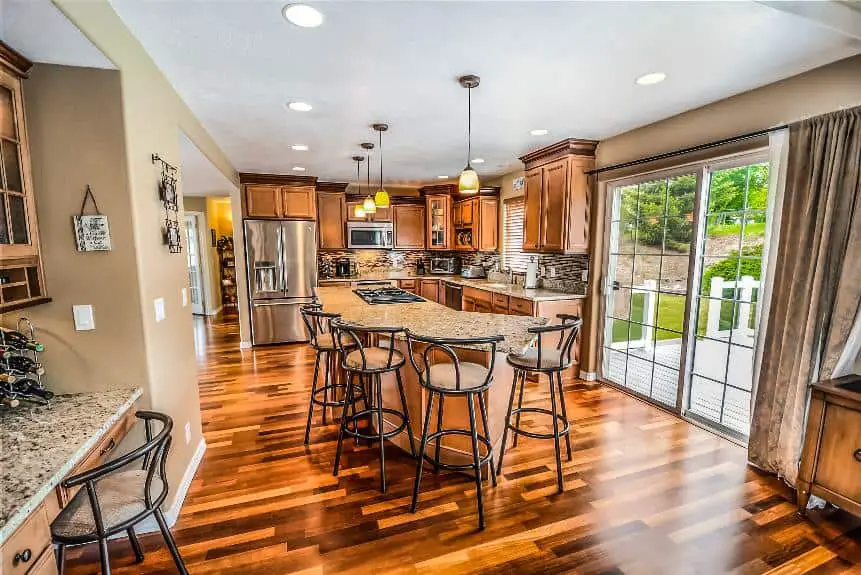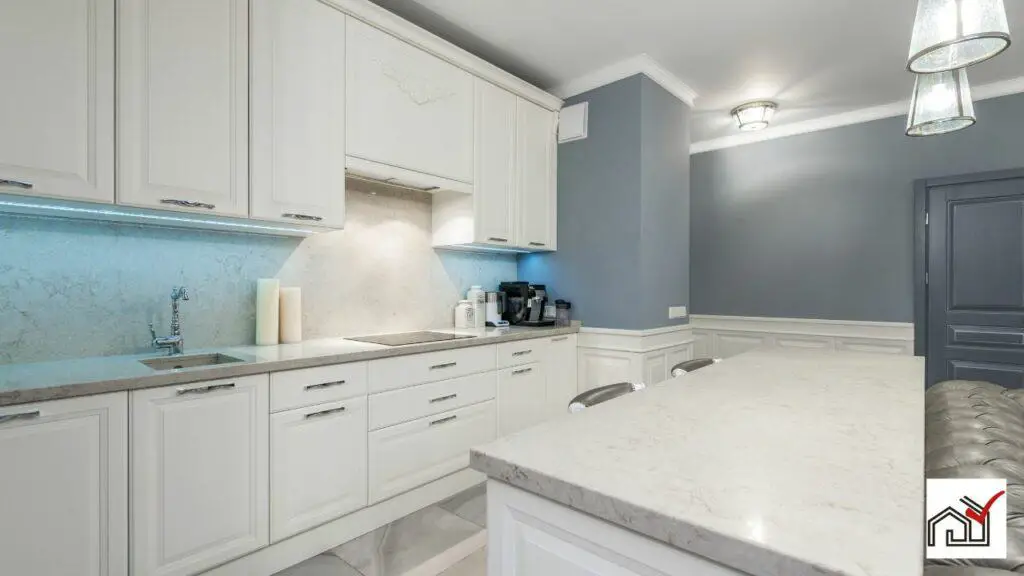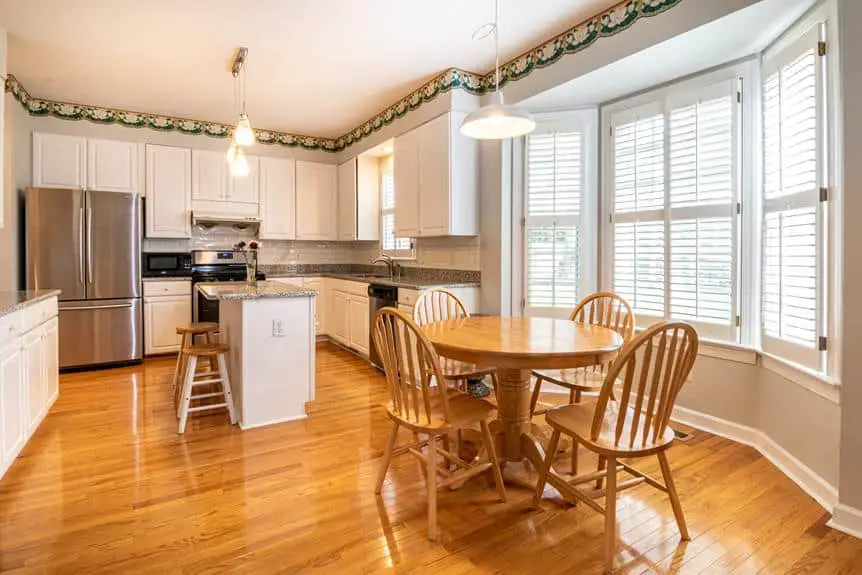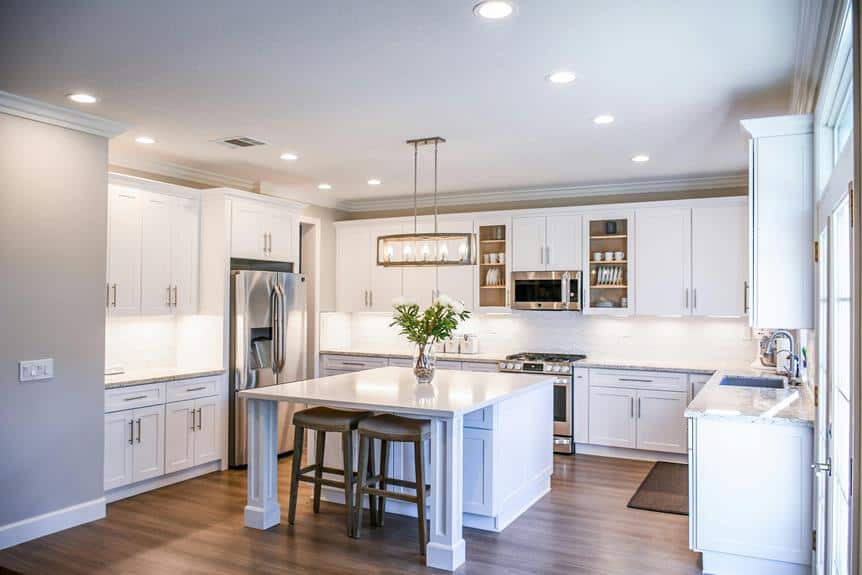For hardwood floors in the kitchen, a durable rug made of synthetic materials like polypropylene is suitable due to its resistance to spills and stains.
Cotton or wool rugs are also options for their aesthetic, but require more maintenance.
The rug's size should fit the kitchen without overpowering it.
It should match the decor and include a non-slip backing and water resistance to protect the floors and provide safety.
The rug should enhance the kitchen's look and comfort.
Assessing Rug Materials
When choosing a kitchen rug for hardwood floors, the material is important for durability, ease of cleaning, and protecting the floor. Synthetic rugs, made from nylon, polyester, or polypropylene, can handle heavy use and spills. They are durable, often machine washable, and may have non-slip backing for safety.
Natural fiber rugs, like wool, add warmth and luxury, are stain-resistant, and durable, but might not be as easy to wash as synthetic rugs. Cotton, hemp, and jute rugs have their own benefits. Cotton is soft, hemp is very durable and resists mildew, and jute has a natural look but is less durable.
The best kitchen rug for hardwood floors should be easy to clean, slip-resistant, comfortable, and fit your style, whether that's a natural fiber's look or synthetic's practicality and affordability.
Prioritizing Durability Features
To protect kitchen hardwood floors, it is important to choose durable rugs. Rugs made from synthetic materials like polypropylene and nylon are ideal for high-traffic areas like kitchens because they are durable and stain-resistant. Wool rugs are also durable and naturally repel stains, making them a good choice for kitchen areas. Hemp rugs are strong, can handle foot traffic, and resist mildew, which is beneficial in kitchens. Seagrass rugs have a reputation for being durable, stain-resistant, and impermeable, protecting hardwood floors from spills.
When picking a kitchen rug, consider how easy it is to clean. Machine-washable rugs are convenient for quick cleaning after spills. Waterproof or water-repellent rugs provide additional protection for the floors from moisture. It's also important to consider the rug's size, color, and cost, as well as maintenance requirements, to ensure it meets the kitchen's needs.
Importance of Easy Cleaning
Kitchen rugs need to be easy to clean to maintain hygiene and durability, particularly because they are used in areas that are likely to experience spills and stains. The most practical kitchen rugs combine functionality with style, prioritizing easy maintenance. In high-traffic kitchens where food and liquids are common, choosing a rug that can be cleaned quickly and thoroughly is important.
Synthetic rugs are often recommended for kitchens due to their stain resistance and ease of cleaning. These rugs can resist spills and are typically simple to wipe down. Many are also machine-washable, which streamlines the cleaning process and ensures a deep clean, important for kitchen cleanliness.
Cotton rugs are another option known for their absorbency, which helps protect wood floors from moisture. They can also be cleaned in a washing machine, making them convenient for active households. Regardless of the rug material, it is critical to vacuum regularly and promptly clean any spills to keep the rug looking good and to protect the floor beneath.
Additionally, kitchen rugs should ideally have non-slip backing or rug pads to enhance safety by preventing slipping, and to make it easier to lift and move the rug for cleaning. A kitchen rug that is easy to clean helps maintain a healthy, safe, and pleasant cooking environment.
Rug Size Selection
To choose the right kitchen rug size, measure the space in front of the sink, dishwasher, and stove to cover high-traffic areas without blocking doors or cabinets.
A runner rug suits these spaces well, protecting floors and fitting kitchen layouts.
Area rugs can also go under tables or in the kitchen's center for comfort and style, but they should be big enough for chairs to stay on the rug when moved.
A rug pad is recommended to prevent slipping and to cushion the rug, extending its lifespan. The pad should be smaller than the rug to keep edges flat.
When selecting a rug, ensure it fits the intended space without interfering with kitchen functions.
Style and Color Considerations
When selecting a kitchen rug, choose one that complements your decor and withstands frequent use. Opt for colors that match your kitchen's palette, with the option to add a subtle or vibrant accent. Neutral colors blend easily, while bold patterns can inject energy into the space and may help conceal stains.
Choose a pattern that aligns with your kitchen's design, whether modern or traditional. A non-slip backing is essential for safety on hardwood floors. Consider your budget and the rug's maintenance needs to ensure it's a feasible choice for your kitchen.
Select a rug that balances style with practicality for the best result.
Ideal Rug Placement
In choosing a kitchen rug, it's important to place it where it's most useful and aesthetically pleasing, without interfering with movement or kitchen access. The rug should be durable and easy to clean, suitable for areas with lots of foot traffic and spills.
It's best positioned in front of the sink, dishwasher, and stove to protect the floors from water and food damage. Ensure the rug is big enough to not block doors or cabinets and lies flat for stability. For safety, use a non-slip rug or add a rug pad to prevent accidents. Choose a low pile rug for ease of cleaning.
Measure your space before buying to guarantee a proper fit, keeping in mind the rug's contribution to the kitchen's function and appearance.
Shopping Guide Tips
To select the right rug for a hardwood-floored kitchen, prioritize durability and style. Choose natural materials like wool or cotton for their longevity and aesthetic. Pick a rug that can handle high traffic, especially near the sink or stove.
Measure your space to ensure the rug fits well. A runner should match the length of your kitchen island and fit between the island and counters without overhanging. A rug with a pile height of around .13 inches is recommended for safety but should be low enough to not obstruct doors or movement.
There are many styles and patterns available. For easy maintenance, consider a machine washable rug. Use a rug pad or tape to keep the rug in place and prevent slipping.
Choose a rug with a smooth backing to protect your hardwood floors from scratches.
Following these guidelines will help you find a rug that is practical and complements your kitchen.




